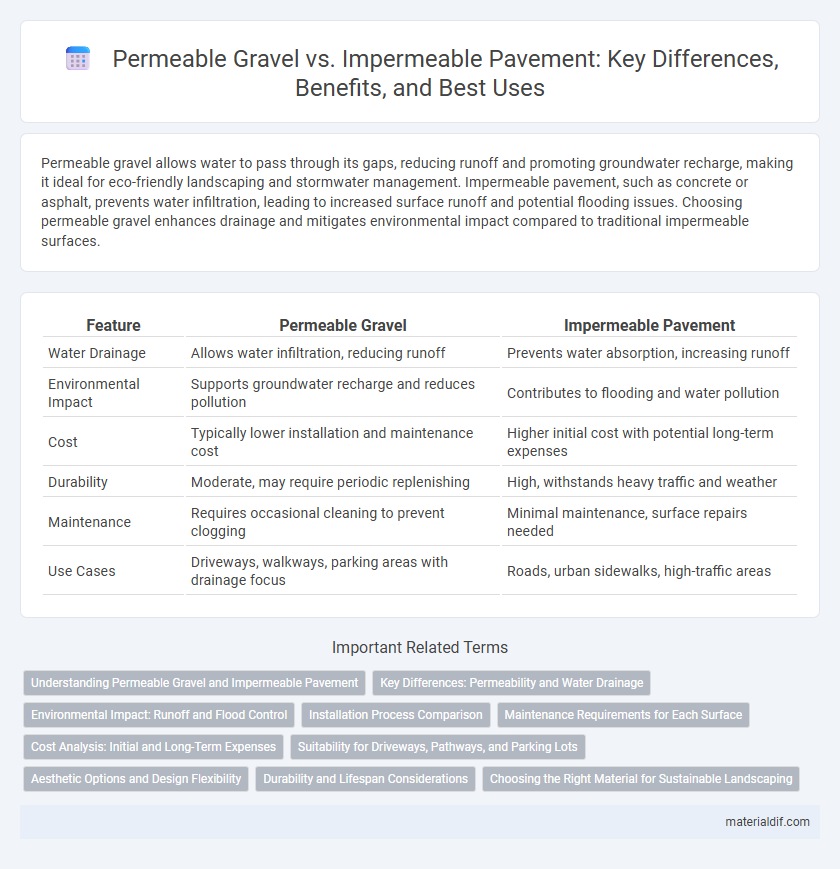Permeable gravel allows water to pass through its gaps, reducing runoff and promoting groundwater recharge, making it ideal for eco-friendly landscaping and stormwater management. Impermeable pavement, such as concrete or asphalt, prevents water infiltration, leading to increased surface runoff and potential flooding issues. Choosing permeable gravel enhances drainage and mitigates environmental impact compared to traditional impermeable surfaces.
Table of Comparison
| Feature | Permeable Gravel | Impermeable Pavement |
|---|---|---|
| Water Drainage | Allows water infiltration, reducing runoff | Prevents water absorption, increasing runoff |
| Environmental Impact | Supports groundwater recharge and reduces pollution | Contributes to flooding and water pollution |
| Cost | Typically lower installation and maintenance cost | Higher initial cost with potential long-term expenses |
| Durability | Moderate, may require periodic replenishing | High, withstands heavy traffic and weather |
| Maintenance | Requires occasional cleaning to prevent clogging | Minimal maintenance, surface repairs needed |
| Use Cases | Driveways, walkways, parking areas with drainage focus | Roads, urban sidewalks, high-traffic areas |
Understanding Permeable Gravel and Impermeable Pavement
Permeable gravel allows water to flow through its porous structure, reducing runoff and promoting groundwater recharge. Impermeable pavement, such as asphalt or concrete, creates a solid barrier that prevents water infiltration, causing increased surface runoff and potential flooding. Understanding the differences in water permeability and environmental impact between these materials is crucial for effective stormwater management and sustainable urban planning.
Key Differences: Permeability and Water Drainage
Permeable gravel allows water to pass through its gaps, promoting natural groundwater recharge and reducing surface runoff, while impermeable pavement prevents water infiltration, causing higher runoff and potential flooding. The key difference lies in permeability; permeable gravel supports efficient water drainage by absorbing rainwater, whereas impermeable pavement directs water off surfaces into drainage systems. This contrast significantly impacts stormwater management and environmental sustainability in urban design.
Environmental Impact: Runoff and Flood Control
Permeable gravel significantly reduces surface runoff by allowing water to infiltrate the ground, which helps recharge groundwater and mitigates flooding risks. In contrast, impermeable pavement prevents water absorption, leading to increased runoff that overwhelms stormwater systems and contributes to urban flooding and water pollution. Using permeable gravel supports sustainable water management by controlling stormwater more effectively and minimizing environmental degradation.
Installation Process Comparison
Permeable gravel installation involves preparing a base layer of crushed stone for drainage, followed by spreading and compacting the gravel to allow water infiltration. Impermeable pavement installation requires multiple layers, including sub-base, binder, and wearing courses, often necessitating specialized equipment and curing time for materials like asphalt or concrete. The permeable gravel process is generally quicker and less labor-intensive, while impermeable pavement requires precise layering and finishing to ensure durability and water resistance.
Maintenance Requirements for Each Surface
Permeable gravel surfaces require regular raking and occasional replenishment to prevent clogging and maintain drainage efficiency, with minimal need for expensive repairs. Impermeable pavements demand frequent cleaning to remove debris and periodic sealing or resurfacing to address cracks and wear, which can incur higher long-term maintenance costs. Proper maintenance of permeable gravel supports sustainable stormwater management, while impermeable surfaces necessitate extensive upkeep to manage water runoff and structural integrity.
Cost Analysis: Initial and Long-Term Expenses
Permeable gravel typically involves lower initial installation costs compared to impermeable pavement, as it requires minimal materials and labor. Long-term expenses for permeable gravel are reduced due to improved stormwater management, which decreases the need for costly drainage infrastructure and maintenance. In contrast, impermeable pavement incurs higher upfront costs and ongoing expenses from frequent repairs and stormwater runoff mitigation systems.
Suitability for Driveways, Pathways, and Parking Lots
Permeable gravel offers superior water drainage, making it ideal for driveways, pathways, and parking lots by reducing runoff and preventing pooling, especially in areas with heavy rainfall. Impermeable pavement, while providing a smooth and durable surface suitable for high-traffic parking lots, often requires additional drainage solutions to manage water accumulation. For residential driveways and walkways, permeable gravel enhances environmental benefits and maintenance ease, whereas impermeable pavement excels in urban settings demanding structural strength and minimal permeability.
Aesthetic Options and Design Flexibility
Permeable gravel offers diverse aesthetic options with natural textures and colors that blend seamlessly into landscapes, enhancing design flexibility for eco-friendly projects. It allows for creative patterns and varying stone sizes, enabling customized looks that suit different architectural styles. In contrast, impermeable pavement typically provides limited design variations, often constrained to uniform colors and smooth surfaces, reducing opportunities for unique visual appeal.
Durability and Lifespan Considerations
Permeable gravel offers superior drainage capabilities that reduce water pooling and freeze-thaw damage, enhancing its durability in various climates. Impermeable pavement, while providing a solid, stable surface, often suffers from cracking and potholes due to water infiltration beneath the surface, shortening its lifespan. Maintenance frequency and environmental exposure are critical factors influencing the longevity of both materials, with permeable gravel generally requiring more upkeep but enduring longer in sustainable applications.
Choosing the Right Material for Sustainable Landscaping
Permeable gravel allows water to infiltrate the soil, reducing runoff and promoting groundwater recharge, making it ideal for sustainable landscaping. Impermeable pavement, such as concrete or asphalt, prevents water absorption, often leading to increased surface runoff and potential flooding issues. Selecting permeable gravel enhances soil health and supports eco-friendly drainage management in landscape design.
Permeable Gravel vs Impermeable Pavement Infographic

 materialdif.com
materialdif.com